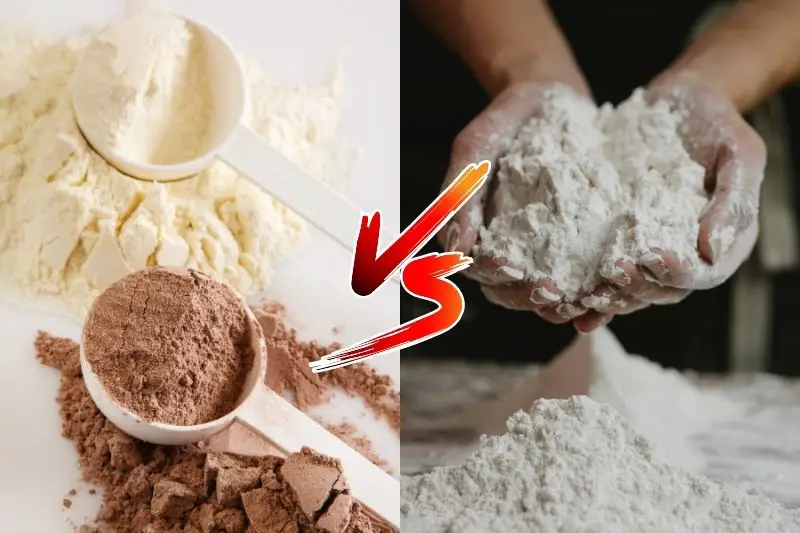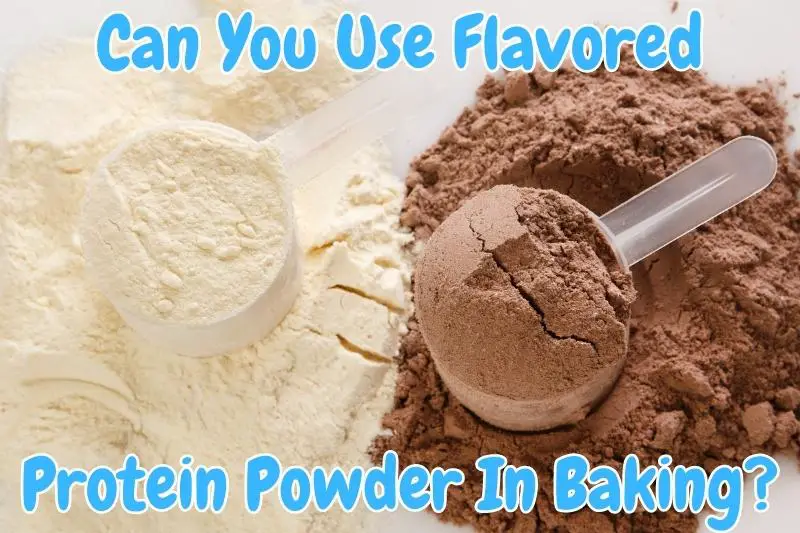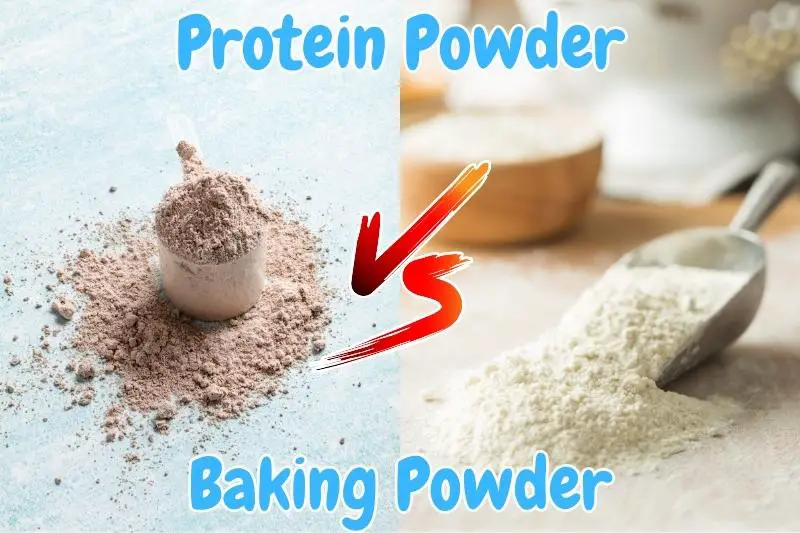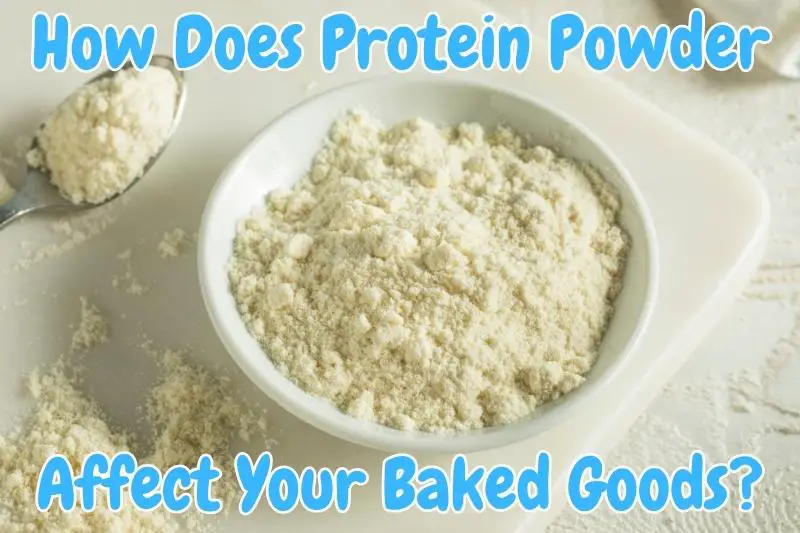This post contains affiliate links.
Desserts are a guilty pleasure we all know and love. For others, they fear it! My husband works out and is always drinking protein shakes. Then I wondered, what if I substituted the flour with protein powder in desserts?
Generally speaking, you can substitute protein powder for flour when baking. Some types of protein powders are better flour substitutes than others depending on what you want to bake. You should typically use an unflavored protein powder as a substitute for the best results.
After experimenting with different types of protein powders to make an array of baked treats, I learned what you should and shouldn’t do when it comes to baking. Below, I explain these secrets in detail!
Can I use protein powder instead of flour?
You can use protein powder as a flour substitute to make cookies, brownies, cakes, muffins, loaves of bread, and even pancakes.

*Side Note: The best protein powder that I’ve ever used for baking was the Quest Nutrition Multi-purpose Protein Powder. This protein powder tasted great in all of the baked goods that I’ve created so far while adding great nutritional value simultaneously. You can check out this protein powder on Amazon!
Since protein powders have dry textures and are able to absorb liquids, in many ways, they act similarly to flour when used for baking. However, there are some key differences that you have to look out for.
- Whey and soy powders are recommended for baking
- Do not replace ALL flour in the recipe with protein powder
- Use more liquids than the recipe calls for
Protein powders come in a variety of forms, and because they are designed differently, some of them have a tendency to coagulate or thicken whenever they are used for baking while others may be lumpy.
It’s been my experience that whey and soy are the two best types of protein powders to use as flour substitutes for baking.
When using protein powder as a flour substitute, you should never use it to replace all of the flour in your recipe.
Instead, at most, when using whey protein powder, you should only substitute about a quarter cup of flour with this ingredient.
Below, I found a short video explaining the benefits of using protein powder for your baking needs:
*Side Note: I recently wrote an article about The Best Ways To Fix & Prevent a Dense Cake. This article talks about how to fix a failed dense cake and prevent it from occurring. You can check out this article here!
When using soy protein powder, you can use it as a substitute for a little more flour, but it should not exceed more than half a cup of flour.
For the best results, I recommend only substituting only about one-third of a cup of flour with soy protein powder.
Since protein powders are typically used for making smoothies and shakes, they are more absorbent than flour.
Here are some common ingredients that I like to add to my recipes when baking with protein powder:
- Applesauce
- Mashed Banana
- Plain Yogurt
- Cottage Cheese
- Mashed Sweet Potatoes
- Sour Cream
When substituting flour with protein powder, it is imperative that you add more liquids to whatever recipe you are making. This added moisture is absolutely necessary in order to avoid a dry or rubbery end result.
Using Flavored Protein Powder in Baking
If you like to use a flavored protein powder normally, then I recommend leaving what you typically use in the pantry and opting for an unflavored version instead.
This is because I’ve found that flavored protein powders don’t make for great flour substitutes when baking.
The reason you should avoid using flavored protein powders as flour substitutes is that flavored protein powders can negatively affect the taste of what you’re baking.

*Side Note: If you want to learn How To Bake A Cake Without Vanilla Extract, I recently wrote an article talking about the Substitutes that you can use for Vanilla Extract, which you can check out here!
When testing different protein powders, I found that flavored ones often ruined whatever I baked by overpowering the other flavors in my desserts and often having an unpleasant aftertaste.
It was also harder to know how to adjust my recipes when using flavored protein powders as they include sugar or other sweeteners, and knowing how much sugar to subtract from recipes was difficult.
On top of that, I also enjoyed the control of not using a flavored protein powder allotted to me.
It is also important to know which type of dessert can be baked with the type of powder, as shown below:
| Whey Protein Powder | Soy Protein Powder |
| Cakes | Brownies |
| Cupcakes | Muffins |
When using flavored protein powders, you become limited in what you can make. This makes it necessary for more adjustments to be made to your recipes in order to compensate for their usage.
This can be costly in both time and money as you try to find the best combination of ingredients.
It’s essential to know that if you’re baking a vegan dish, then you should not use whey protein powder to substitute flour as whey protein powders are not vegan.
When substituting soy protein powder for flour, keep in mind that it has a nutty flavor.
When using protein powders for baking, you should always weigh them rather than rely on cup measurements in order to avoid using too much of them.
Can I use protein powder instead of baking powder?
Generally speaking, you can’t use protein powders instead of baking powder for baking since they don’t contain specific chemical properties that act as leavening agents. Baking powder possesses the leavening agents necessary to make your baked goods rise while protein powders do not.
Since protein powders are more absorbent than flour, when using them in a recipe, you need to add more moisture to prevent unsatisfactory end results.
For this reason, I like to use liquid baking powder substitutes whenever I bake with protein powders as doing this is an excellent way for me to naturally add more moisture to my recipes.

The two baking powder substitutes that I like to use most are buttermilk and plain yogurt.
You can substitute buttermilk for baking powder by combining half a cup of buttermilk with a quarter teaspoon of baking soda.
This combination substitutes one teaspoon of baking powder, and you can adjust it according to the needs of your recipe.
To use plain yogurt rather than buttermilk as a baking powder substitute, the recipe for one teaspoon of baking powder is the same: a quarter teaspoon of baking soda mixed with half a cup of plain yogurt.
*Side Note: You might also want to know why your cakes can sometimes come out Crumbly or Moist. I dug into the root of the problem and I wrote an article about Preventing and Fixing Crumbly and Moist Cakes, which you can check out here!
How does protein powder Affect baking?
When used as a flour substitute, protein powder can add protein and other beneficial nutrients to your baked goods. Since protein powder is more absorbent than flour, it’s important to add more liquids to your recipe to avoid a dry or rubbery texture.
Generally speaking, the type of protein powder you use will determine what effects on baking you may face.
For example, when using whey protein powder, you may have to bake your treats at a lower temperature and for longer as whey protein powder can’t handle temperatures that are too high.

Protein powders can affect baking in a few different ways:
1. They can make the texture of what you’re baking harder. You can prevent this by not overmixing your batter when using protein powders.
When substituting flour with protein powder, it’s crucial that you add in the protein powder last and only mix your ingredients until they are just combined,
2. Some protein powders like whey require that you bake your treats at a lower temperature. I recommend adjusting the temperature of your recipe down by about 25 degrees Fahrenheit.
3. Whey protein powders can brown things faster than normal. To prevent this from happening to what you’re baking, I recommend covering it with aluminum foil until it is halfway done.
4. Plant-based protein powders are even more absorbent than some of the other types. Because of this, even more, changes are needed to your recipe in order to add in more moisture.
To do this, I recommend using less flour or dry ingredients to make your baked treat as well as adding more liquid ingredients in order to prevent making a dry and dense dessert.
I recently came across The Perfect-Sized Plastic Round Storage Containers that can fit anything in them from a pie to even cupcakes. These containers come in a 2-pack and are Microwave and Dishwasher safe! You can check out these containers on Amazon!
Does protein powder taste good in a cake?
In general, protein powders can taste good in cakes depending on the flavors of protein powder used in combination with all the other ingredients. It’s important to look over the ingredient list of the powder you are using as some have ingredients in them that can ruin the taste of your cakes.
After recognizing which flavors of protein powders taste good in cakes, I recommend using the protein powder every time you decide to bake a cake.
After all, it won’t harm if your baked good or dessert will have additional nutritional value in it, in the form of protein.
According to The Flexitarian:
“Beyond smoothies and shakes, protein powders can be a very useful kitchen staple. Incorporating them to cakes and other baking recipes, is an easy way to add healthy protein to your diet whether you workout out often or want to supplement your vegan, vegetarian or flexitarian diet.“
The Flexitarian
Some more affordable protein powders can have fillers or sweeteners in them that can make your cakes taste bad.
Because of this, when using protein powder to make cakes, I recommend avoiding some of the cheaper options.
*By the way, you might also want to know How To Bake A Cake Without A Cake Pan. I recently wrote an article that talks about How To Bake A Cake If You Don’t Have A Cake Pan. You can find this article here!
